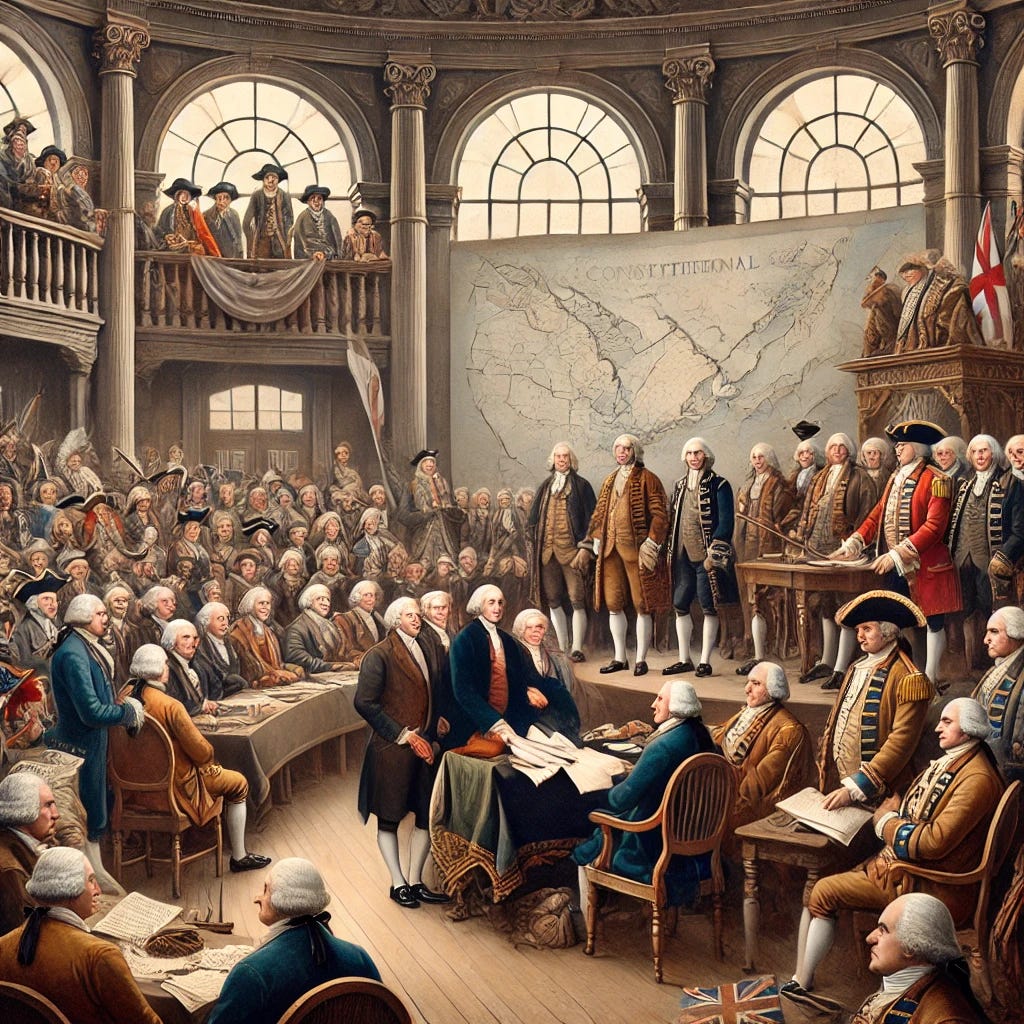The 1791 Constitutional Act: A Turning Point for First Nations Land and Governance
Introduction
The 1791 Constitutional Act (also known as the Canada Act) was a major legislative change that divided Quebec into two separate colonies: Upper Canada (Ontario) and Lower Canada (Quebec). This restructuring was meant to accommodate British Loyalist settlers while maintaining the legal and religious rights of French-speaking Catholics in Lower Canada.
But what about the First Nations?
Unlike earlier colonial laws, this act did not mention First Nations at all. It failed to recognize their sovereignty, land rights, or treaty relationships with the Crown. This silence on First Nations issues marked a major shift in British policy—one that would lead to decades of land dispossession, governance exclusion, and legal battles that continue today.
Historical Context
After the American Revolution (1775-1783), thousands of Loyalists fled to British North America, settling in the Province of Quebec. The British government saw an opportunity to restructure Quebec to accommodate these new settlers.
However, there was a problem:
The 1763 Royal Proclamation had recognized First Nations sovereignty and land rights, requiring that land sales could only occur through the Crown.
Many First Nations in the Great Lakes, Ohio Valley, and St. Lawrence regions still understood their relationship with the Crown as nation-to-nation.
The Quebec Act of 1774 had also failed to address First Nations directly, but at least it preserved French law and customs, indirectly recognizing First Nations land rights under seigneurial tenure.
With the 1791 Constitutional Act, Britain ignored First Nations entirely, setting the stage for increased colonial expansion into First Nations lands without consultation or treaty negotiations.
Full Text of the 1791 Constitutional Act
The 1791 Constitutional Act is long, but its main provisions include:
Dividing Quebec into Two Colonies
Upper Canada (modern-day Ontario) was created for English-speaking Protestant settlers, with English common law and freehold land tenure.
Lower Canada (modern-day Quebec) remained largely French-speaking and Catholic, with French civil law and the seigneurial land system.
No mention of First Nations land rights, governance, or treaties.
Creating Legislative Councils and Assemblies
Each colony got a Legislative Assembly and a Legislative Council, introducing a representative government for settlers.
However, First Nations were not given any role in this new political system.
Land Allocations for Protestant Clergy
One-seventh of all Crown land was set aside for Protestant churches (Clergy Reserves).
No lands were set aside for First Nations, despite their long-standing use and governance of these territories.
Introduction of Freehold Land Ownership in Upper Canada
While Lower Canada maintained the French seigneurial land system, Upper Canada adopted British-style private property laws.
This system encouraged private land ownership and sales, increasing pressure on First Nations lands.
📜 The full text of the Act can be found here
What Changed for First Nations?
1. Shift Away from Treaty-Based Relationships
Before 1791, British policy explicitly recognized First Nations rights in treaties and legal documents such as:
The 1763 Royal Proclamation, which required the Crown to negotiate land sales with First Nations.
The Peace and Friendship Treaties, which maintained First Nations control over their territories.
The 1791 Act removed First Nations from the political conversation entirely. Instead of dealing with First Nations as sovereign nations, the British focused solely on settlers and colonial governance.
2. Loss of Land Protections
First Nations land was no longer formally protected under British law.
The Act allowed direct land sales to settlers, opening the door for massive land loss.
The government prioritized expanding settlements over respecting treaty agreements.
3. Exclusion from Political Representation
The Act created two colonial governments—but neither included First Nations voices or governance structures.
First Nations leaders were not consulted on laws that impacted their lands.
They could not vote or hold office in the new colonial system.
By excluding First Nations from governance, the Act contributed to a legal framework that justified later policies of assimilation and land dispossession.
Did This Act Cause Confusion?
Yes. The 1791 Constitutional Act created a legal grey area that led to future disputes.
First Nations still viewed themselves as treaty partners with the British Crown.
Settlers and colonial officials saw First Nations land as unoccupied territory ready for development.
The British government’s silence on First Nations allowed settlers to push for more land, regardless of past treaty commitments.
This misunderstanding shaped Canadian legal battles for centuries. Even today, courts debate the extent of First Nations land rights based on pre- and post-1791 legal interpretations.
Key Takeaways
The 1791 Constitutional Act ignored First Nations governance, treaties, and land rights.
Land protections from the 1763 Royal Proclamation were weakened, leading to increased settlement and land loss.
First Nations were excluded from colonial government, leaving them without formal representation.
This was a turning point in British-First Nations relations, shifting from treaty-based diplomacy to colonial land expansion.
Lasting Impact
Land disputes and treaty negotiations continue today, as First Nations argue that their rights were never extinguished.
Canada’s modern policies toward First Nations must reckon with the fact that this Act set the stage for future assimilation policies.
The exclusion of First Nations from governance in 1791 helped justify later policies like the Indian Act (1876) and residential schools.
Next in the Series
The 1840 Act of Union, which merged Upper and Lower Canada, further shaped the treatment of First Nations by centralizing government control over land and resources.






Treachery; a word that conjures tales of betrayal, deceit, and broken trust. Throughout history, treachery has played a pivotal role in shaping events, from dramatic betrayals in political coups to personal stories of deceit in literature and legend.
Indigenous History and Treaties; treachery was often at play in the history of colonization, where promises made to Indigenous nations were frequently broken.
Treachery; is a force that alters destinies and undermines trust, making it a central theme in everything from epic sagas to modern diplomacy.